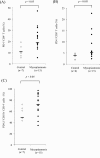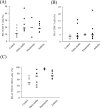Increase of cells expressing PD-1 and PD-L1 and enhancement of IFN-γ production via PD-1/PD-L1 blockade in bovine mycoplasmosis
- PMID: 28544524
- PMCID: PMC5569371
- DOI: 10.1002/iid3.173
Increase of cells expressing PD-1 and PD-L1 and enhancement of IFN-γ production via PD-1/PD-L1 blockade in bovine mycoplasmosis
Abstract
Introduction: Bovine mycoplasma, chiefly Mycoplasma bovis, is a pathogen that causes pneumonia, mastitis, arthritis, and otitis media in cattle. This pathogen exerts immunosuppressive effects, such as the inhibition of interferon production. However, the mechanisms involved in bovine mycoplasmosis have not been fully elucidated. In this study, we investigated the role of the programmed death-1 (PD-1)/programmed death-ligand 1 (PD-L1) pathway in immunosuppression in bovine mycoplasmosis.
Methods: In the initial experiments, we used enzyme-linked immunosorbent assay to measure interferon-γ (IFN-γ) from peripheral blood mononuclear cells (PBMCs) isolated from cattle with mycoplasmosis.
Results: Expectedly, IFN-γ production significantly decreased in cattle with mycoplasmosis compared with that in clinically healthy cattle. Concomitantly, flow cytometric analysis revealed that the proportions of PD-1+ CD4+ and PD-L1+ CD14+ cells significantly increased in peripheral blood of the infected cattle. Interestingly, the number of PD-1+ CD4+ and PD-1+ CD8+ T cells were negatively correlated with IFN-γ production from PBMCs in bovine mycoplasmosis. Additionally, blockade of the PD-1/PD-L1 pathway in vitro by anti-bovine PD-1- and anti-bovine PD-L1 antibodies significantly upregulated the production of IFN-γ from anti-mycoplasma-specific cells.
Conclusions: These results suggest that the PD-1/PD-L1 pathway could be involved in immune exhaustion of bovine mycoplasma-specific T cells. In conclusion, our study opens up a new perspective in the therapeutic strategy for bovine mycoplasmosis by targeting the immunoinhibitory receptor pathways.
Keywords: Bovine mycoplasmosis; IFN-γ; PD-1; PD-L1; immunosuppression.
© 2017 The Authors. Immunity, Inflammation and Disease Published by John Wiley & Sons Ltd.
Figures





Similar articles
-
Mycoplasma bovis-Induced Inhibition of Bovine Peripheral Blood Mononuclear Cell Proliferation Is Ameliorated after Blocking the Immune-Inhibitory Programmed Death 1 Receptor.Infect Immun. 2018 Feb 20;86(3):e00921-17. doi: 10.1128/IAI.00921-17. Print 2018 Mar. Infect Immun. 2018. PMID: 29311234 Free PMC article.
-
Upregulation of PD-L1 Expression by Prostaglandin E2 and the Enhancement of IFN-γ by Anti-PD-L1 Antibody Combined With a COX-2 Inhibitor in Mycoplasma bovis Infection.Front Vet Sci. 2020 Feb 20;7:12. doi: 10.3389/fvets.2020.00012. eCollection 2020. Front Vet Sci. 2020. PMID: 32154274 Free PMC article.
-
Combined Immune Checkpoint Blockade Enhances Antiviral Immunity against Bovine Leukemia Virus.J Virol. 2023 Jan 31;97(1):e0143022. doi: 10.1128/jvi.01430-22. Epub 2023 Jan 4. J Virol. 2023. PMID: 36598199 Free PMC article.
-
Virulence, persistence and dissemination of Mycoplasma bovis.Vet Microbiol. 2015 Aug 31;179(1-2):15-22. doi: 10.1016/j.vetmic.2015.02.024. Epub 2015 Mar 2. Vet Microbiol. 2015. PMID: 25824130 Review.
-
What does PD-L1 positive or negative mean?J Exp Med. 2016 Dec 12;213(13):2835-2840. doi: 10.1084/jem.20161462. Epub 2016 Nov 30. J Exp Med. 2016. PMID: 27903604 Free PMC article. Review.
Cited by
-
Immune Evasion of Mycoplasma bovis.Pathogens. 2021 Mar 4;10(3):297. doi: 10.3390/pathogens10030297. Pathogens. 2021. PMID: 33806506 Free PMC article. Review.
-
Mycoplasma bovis-Induced Inhibition of Bovine Peripheral Blood Mononuclear Cell Proliferation Is Ameliorated after Blocking the Immune-Inhibitory Programmed Death 1 Receptor.Infect Immun. 2018 Feb 20;86(3):e00921-17. doi: 10.1128/IAI.00921-17. Print 2018 Mar. Infect Immun. 2018. PMID: 29311234 Free PMC article.
-
Programmed death-ligand 1 expression in swine chronic infections and enhancement of interleukin-2 production via programmed death-1/programmed death-ligand 1 blockade.Immun Inflamm Dis. 2021 Dec;9(4):1573-1583. doi: 10.1002/iid3.510. Epub 2021 Aug 20. Immun Inflamm Dis. 2021. PMID: 34414683 Free PMC article.
-
1,8-Cineol Attenuates Checkpoint Molecule PDL-1 and Adhesion Molecule CX3CR1 in Circulating Monocytes in Otitis Media Patients.J Pers Med. 2024 Mar 1;14(3):279. doi: 10.3390/jpm14030279. J Pers Med. 2024. PMID: 38541021 Free PMC article.
-
The PD-1/PD-L1 Pathway: A Perspective on Comparative Immuno-Oncology.Animals (Basel). 2022 Oct 4;12(19):2661. doi: 10.3390/ani12192661. Animals (Basel). 2022. PMID: 36230402 Free PMC article. Review.
References
-
- Gagea, M. I. , Bateman K. G., Shanahan R. A., van Dreumel T., McEwen B. J., Carman S., Archambault M., and Caswell J. L.. 2006. Naturally occurring Mycoplasma bovis‐associated pneumonia and polyarthritis in feedlot beef calves. J. Vet. Diagn. Invest. 18:29–40. - PubMed
-
- Caswell, J. L. , Bateman K. G., Cai H. Y., and Castillo‐Alcala F.. 2010. Mycoplasma bovis in respiratory disease of feedlot cattle. Vet. Clin. North Am. Food Anim. Pract. 26:365–379. - PubMed
-
- Fox, L. K. 2012. Mycoplasma mastitis: causes, transmission, and control. Vet. Clin. North Am. Food Anim. Pract. 28:225–237. - PubMed
-
- Manual of Diagnostic Tests Vaccines for Terrestrial Animals, Part 2, Sect 2.4, Chapter 2.4.8. Office International des Epizooties, Paris. 2014. http://www.oie.int/en/international‐standard‐setting/terrestrial‐manual/...
-
- Higuchi, H. , Iwano H., Gondaira S., Kawai K., and Nagahata H.. 2011. Prevalence of Mycoplasma species in bulk tank milk in Japan. Vet. Rec. 169:442. - PubMed
Publication types
MeSH terms
Substances
LinkOut - more resources
Full Text Sources
Other Literature Sources
Molecular Biology Databases
Research Materials

